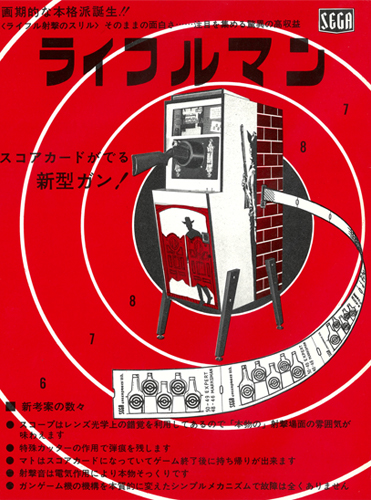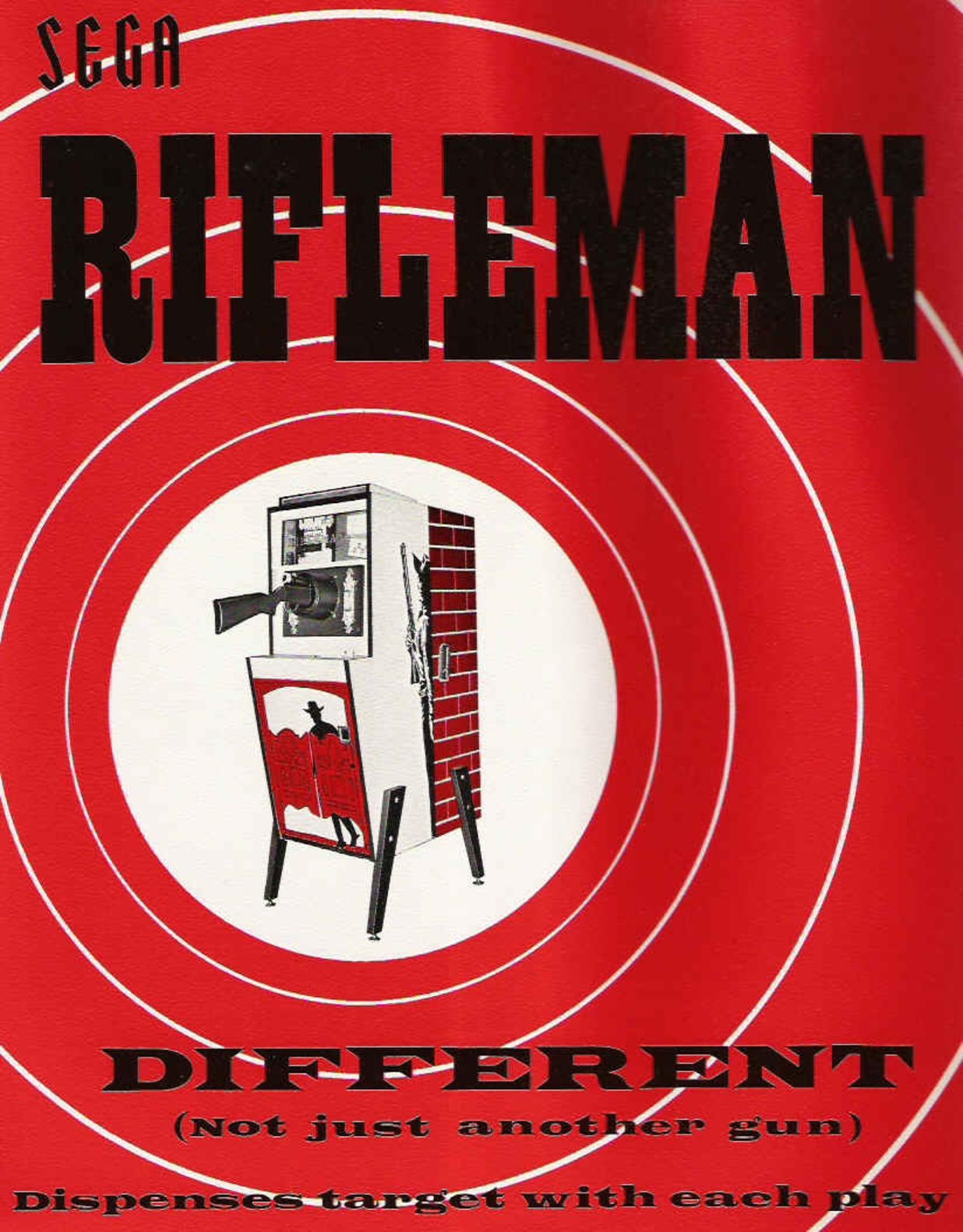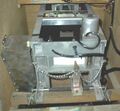Difference between revisions of "Rifleman"
From Sega Retro
m (+logo) |
m |
||
| Line 8: | Line 8: | ||
| genre= | | genre= | ||
| releases={{releasesArcade | | releases={{releasesArcade | ||
| − | | em_date_jp=1967{{ref|https://web.archive.org/web/ | + | | em_date_jp=1967{{ref|https://web.archive.org/web/20240323054507/https://earlyarcadesjapan.blogspot.com/2024/02/1967-rifleman-by-sega.html}} |
| em_date_us=1967 | | em_date_us=1967 | ||
| + | | em_date_eu=196x{{ref|https://web.archive.org/web/20240323054507/https://earlyarcadesjapan.blogspot.com/2024/02/1967-rifleman-by-sega.html} | ||
}} | }} | ||
}} | }} | ||
| − | {{sub-stub}}'''''{{PAGENAME}}''''' is a 1967 electro-mechanical [[arcade]] shooting game manufactured by [[Sega]]. After finishing ten shots for ten cents, it prints out a card (formally known as a "ticket") that is extracted on the right side of the cabinet. This card is a print of where the shots landed in relation to the bullseye targets. The cards are in roll form. | + | {{sub-stub}}'''''{{PAGENAME}}''''' (ライフルマン) is a 1967 electro-mechanical [[arcade]] shooting game manufactured by [[Sega]]. After finishing ten shots for ten cents, it prints out a card (formally known as a "ticket") that is extracted on the right side of the cabinet. This card is a print of where the shots landed in relation to the bullseye targets. The cards are in roll form. |
The player gets either five or ten shots (depending on the machine's setting) to take aim and shoot at a moving paper target card roll seen by looking through the rifle scope. The paper card is pulled through the machine from left to right, while at the same time, an opening/closing door is cycling in front of the card, allowing the player to see the card for only a split second before the door closes, again. The door movement is similar to that of swinging bar doors, as pictured on the front of the cabinet. The card has photos of five bottles on it, with bulls-eyes on the bottles and is labeled with point values from five to ten per bottle. | The player gets either five or ten shots (depending on the machine's setting) to take aim and shoot at a moving paper target card roll seen by looking through the rifle scope. The paper card is pulled through the machine from left to right, while at the same time, an opening/closing door is cycling in front of the card, allowing the player to see the card for only a split second before the door closes, again. The door movement is similar to that of swinging bar doors, as pictured on the front of the cabinet. The card has photos of five bottles on it, with bulls-eyes on the bottles and is labeled with point values from five to ten per bottle. | ||
| Line 19: | Line 20: | ||
Purchase of a ''{{PAGENAME}}'' machine comes with one roll of 3,000 paper cards. Replacement rolls could be acquired from [[Sega Enterprises]] for ¥3,000 each.{{fileref|1977SegaPriceList JP.pdf|page=6}} | Purchase of a ''{{PAGENAME}}'' machine comes with one roll of 3,000 paper cards. Replacement rolls could be acquired from [[Sega Enterprises]] for ¥3,000 each.{{fileref|1977SegaPriceList JP.pdf|page=6}} | ||
| + | |||
| + | ==History== | ||
| + | ===Development=== | ||
| + | ''{{PAGENAME}}'' is directly based on Helmut Rehbock's 1966 German arcade game ''Schützenstand'', using virtually-identical operating mechanics, score cards, and even using a strikingly-similar promotional flyer.{{ref|https://web.archive.org/web/20240323054507/https://earlyarcadesjapan.blogspot.com/2024/02/1967-rifleman-by-sega.html}} | ||
==Specifications== | ==Specifications== | ||
| Line 25: | Line 30: | ||
==Promotional material== | ==Promotional material== | ||
| − | {{gallery | + | {{gallery| |
| − | |{{gitem|Rifleman EM US flyer.pdf|US flyer}} | + | {{gitem|Rifleman EM JP flyer.jpeg|JP flyer}} |
| + | {{gitem|Rifleman EM US flyer.pdf|US flyer}} | ||
}} | }} | ||
Revision as of 01:54, 23 March 2024
{{Bob | logo=Rifleman logo.png | image=Rifleman machine1.jpg | publisher=Sega | developer=Sega | system=Electro-mechanical arcade | players=1 | genre= | releases=
|-
|-
|-
|-
|-
|-
|-
|-
|-
|-
|-
|-
|-
|-
|-
|-
|-
|-
|-
|-
|-
|-
|-
|
JP || 1967[1] || ¥? || ?
|-
|
US || 1967 || $? || ?
|-
|-
|
EU || 196x[2] || €? || ?
|-
|-
|-
|-
|-
|-
|-
|-
|-
|-
|-
|-
|-
|-
|-
|-
|-
|-
|-
|-
|-
|-
|-
|-
|-
|-
|-
|-
|-
|-
|-
|-
|-
|-
|-
|-
|-
|-
|-
|-
|-
|-
|-
|-
|-
|-
|-
|-
|-
|-
|-
|-
|-
|-
|-
|-
|-
|-
|-
|-
|-
|-
|-
|-
|-
|-
|-
|-
|-
|-
|-
|-
|-
|-
|-
|-
|-
|-
|-
|-
|-
|-
|-
|-
|-
|-
|-
|-
|-
|-
|-
|-
|-
|-
|-
|-
|-
|-
|-
|-
|-
|-
|-
|-
|-
|-
|-
|-
|-
|-
|-
|-
|-
|-
|-
|-
|-
|-
|-
|-
|-
|-
|-
|-
|-
|-
|-
|-
|-
|-
|-
|-
|-
|-
|-
|-
|-
|-
|-
|-
|-
|-
|-
|-
|-
|-
|-
|-
|-
|-
|-
|-
|-
|-
|-
|-
|-
|-
|-
|-
|-
|-
|-
|-
|-
|-
|-
|-
|-
|-
|-
|-
|-
|-
|-
|-
|-
|-
|-
|-
|-
|-
|-
|-
|-
|-
|-
|-
|-
|-
|-
|-
|-
|-
|-
|-
|-
|-
|-
|-
|-
|-
|-
|-
|-
|-
|-
|-
|-
|-
|-
|-
|-
|-
|-
|-
|-
|-
|-
|-
|-
|-
|-
|-
|-
|-
|-
|-
|-
|-
|-
|-
|-
|-
|-
|-
|-
|-
|-
|-
|-
|-
|- |- | style="display:none" |
|-
This teeny-tiny article needs some work. You can help us by expanding it.
Rifleman (ライフルマン) is a 1967 electro-mechanical arcade shooting game manufactured by Sega. After finishing ten shots for ten cents, it prints out a card (formally known as a "ticket") that is extracted on the right side of the cabinet. This card is a print of where the shots landed in relation to the bullseye targets. The cards are in roll form.
The player gets either five or ten shots (depending on the machine's setting) to take aim and shoot at a moving paper target card roll seen by looking through the rifle scope. The paper card is pulled through the machine from left to right, while at the same time, an opening/closing door is cycling in front of the card, allowing the player to see the card for only a split second before the door closes, again. The door movement is similar to that of swinging bar doors, as pictured on the front of the cabinet. The card has photos of five bottles on it, with bulls-eyes on the bottles and is labeled with point values from five to ten per bottle.
The object is to get five, ten point shots. When the trigger is pulled, the shot is recorded on the card with a pin prick to show where the shot hit. Then, the card is cut off within the machine and dispensed out the right side of the cabinet. The player has a record of their shots and can count up a total score. Each card is about 5" long and 2-3/8" wide, with the description of Expert, Marksman or Sharpshooter if the total points equal 50, 49 or 48 out of 50.
Purchase of a Rifleman machine comes with one roll of 3,000 paper cards. Replacement rolls could be acquired from Sega Enterprises for ¥3,000 each.[3]
Contents
History
Development
Rifleman is directly based on Helmut Rehbock's 1966 German arcade game Schützenstand, using virtually-identical operating mechanics, score cards, and even using a strikingly-similar promotional flyer.[1]
Specifications
Dimensions
Promotional material
Photo gallery
Physical scans
References
- ↑ 1.0 1.1 https://earlyarcadesjapan.blogspot.com/2024/02/1967-rifleman-by-sega.html (Wayback Machine: 2024-03-23 05:45)
- ↑ [https://web.archive.org/web/20240323054507/https://earlyarcadesjapan.blogspot.com/2024/02/1967-rifleman-by-sega.html} https://earlyarcadesjapan.blogspot.com/2024/02/1967-rifleman-by-sega.html}] (Wayback Machine: 2024-03-23 05:45)
- ↑ 1977 Sega Price List, page 6









